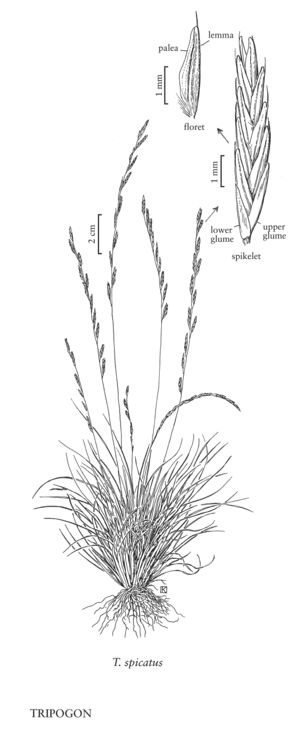Tripogon spicatus
Plants perennial; cespitose. Culms (4.5) 6-34 cm; nodes 2-3, glabrous. Leaves mostly basal; sheaths mostly glabrous, but with tufts of hairs flanking the collar; ligules 0.2-0.3 mm, truncate; blades 1.9-10 cm long, 0.2-1.1 mm wide, glabrous or the adaxial surfaces and margins sparsely pubescent. Inflorescences (1.5) 4-10 cm long, 1.5-3.5 mm wide, with (6) 13-22 spikelets; pedicels 0-0.5 mm, glabrous. Spikelets 4.5-12 mm long, 1-1.3 mm wide, with 5-14 florets; rachilla segments glabrous except for an apical tuft of hairs. Glumes unequal, exceeded by the basal florets; lower glumes (1.2) 1.5-2.4 mm, glabrous, 1-veined, scabridulous over the veins; upper glumes 1.9-2.6 mm, glabrous, 1-veined; lowest lemmas 2.3-3.1 mm, 3-veined, apical sinuses 0.1-0.3 mm deep; awns 0.2-0.9 mm, straight; paleas 1.6-2.4 mm, glabrous on the back and minutely pubescent on the margins; anthers 3, 0.3-0.4 mm, yellow to purple. Caryopses 1-1.5 mm, reddish-brown. 2n = 20.
Discussion
Tripogon spicatus grows in shallow rocky soils, usually on granite outcroppings, occasionally on lime¬stone. The flowering period, April-July(October, November), apparently depends on rainfall. Its range includes the West Indies, Mexico, and South America, in addition to central Texas.
Selected References
None.
Lower Taxa
"decumbent" is not a number.
